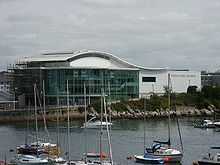National Marine Aquarium, Plymouth
|
National Aquarium Plymouth logo | |
|
Entrance to the National Marine Aquarium | |
| Date opened | 1998[1] |
|---|---|
| Location | Plymouth, England |
| Coordinates | 50°22′00″N 4°07′53″W / 50.3666°N 4.1313°WCoordinates: 50°22′00″N 4°07′53″W / 50.3666°N 4.1313°W |
| Number of animals | 4,000 |
| Number of species | 400 |
| Volume of largest tank | 2,500,000 l (660,000 US gal) |
| Memberships | BIAZA[2] |
| Website |
www |
The National Marine Aquarium is a marine aquarium on reclaimed land in the city of Plymouth, England, in Sutton Harbour, next to the Barbican and fishmarket. It was opened in May 1998,[1] with charitable aims of research, education and conservation. It is the largest aquarium in the United Kingdom.
It is a member of the British and Irish Association of Zoos and Aquariums (BIAZA).
Exhibits

The Aquarium is divided into four main zones: Plymouth Sound, British Coasts, Atlantic Ocean and Blue Planet. A visit to the aquarium goes from the local waters of Plymouth to the Great Barrier Reef of Australia.
- Plymouth Sound
This zone displays marine life found around Plymouth. It concentrates on the surprising range of habitats found around the City. Most animals displayed in this zone are found in shallow water. sea stars, rays, lobsters, and an octopus.
- British Coasts
As visitors move on to the coasts of Britain, they can discover the potential of renewable energy from our Oceans. This zone houses life-size models of whales and dolphins found around Britain and the large Eddystone tank displays creatures found on the Eddystone reef, 12 miles offshore from Plymouth. Through a huge window, visitors can see conger eels, mullet, pollack, bream, and smooth hound sharks swimming in the open water, flatfish and rays hiding on the seabed, and lobsters and crabs hiding in the rocks.
- Atlantic Ocean
This zone contains various areas within, including 'Ocean Drifters', 'Ocean Lab', 'Observation Deck', 'Lost At Sea' and 'Ocean Predators' The 'Ocean Drifters' jelly exhibit was opened in 2009, and includes moon jellies, Japanese sea nettles, and Upside-down jellyfish, housed in round tanks to prevent damage to their delicate bodies. The other areas take you around the largest tank of the aquarium housing 1,000 Caribbean fish including grey nurse shark, barracuda, southern stingray and tarpon. The tank volume is 2.5 million litres. This exhibit was updated at the end of 2009, with the largest ever shipment of live fish into the UK, from Barbados, West Indies. The aquarium introduced more than 18 new species.[3]
- Blue Planet
This zone includes 'Biozone' and the 'Great Barrier Reef'. Biozone showcases the amazing biodiversity found in the world's oceans and displays longhorn cowfish, lionfish, Giant Pacific Octopus Enteroctopus dofleini and seahorses. The Great Barrier Reef exhibit is the grand finale of the visit. The second largest tank displays some of the most colourful fish in the world.
Conservation
The National Marine Aquarium led a project to sink frigate HMS Scylla in 2004 to create an artificial reef in Whitsand Bay, Cornwall.[4] It is the lead partner in Just Add H2O, a schools learning centre.
References
- ↑ 1.0 1.1 "National Marine Aquarium". historyofplymouth.co.uk. Plymouth Places. Retrieved 22 February 2011.
- ↑ "BIAZA Zoos and Aquariums". biaza.org.uk. BIAZA. Retrieved 21 February 2011.
- ↑ Staff Writer (10 September 2009). "Caribbean fish to be flown to UK". BBC News. Retrieved 13 September 2009.
Eighteen species of fish will be flown from Ocean Park in Barbados to a new home at the National Marine Aquarium. The 42-tonne consignment of 100 fish, in 19 specially-constructed tanks, is said to be the biggest ever shipment of live fish into the UK.
- ↑ wrecktoreef Web site:Artifical reef has generated millions for the Cornish economy, 7 April 2014
External links
 Media related to National Marine Aquarium at Wikimedia Commons
Media related to National Marine Aquarium at Wikimedia Commons- Official website
| ||||||||||||||||||||||||||

